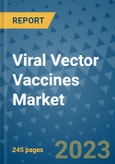Market Insights
Viral vector vaccines deliver genetic material into host cells to stimulate an immune response, offering a powerful mechanism for combating various infectious diseases. With only a limited number of FDA-approved viral vector vaccines available - primarily for Ebola and COVID-19 - the scope for development and deployment remains vast. The market has gained momentum due to the success of viral vector vaccines in managing public health emergencies, particularly in high-risk zones such as parts of Africa and developing economies.Adults constitute the largest patient demographic using viral vector vaccines, with hospitals being the primary distribution channel. With growing interest from both government and private stakeholders, manufacturers are increasing investments in R&D and production capacities to meet rising demand.
Key Market Drivers
1. Rising Prevalence of Infectious Diseases:The global surge in infectious diseases, including Ebola, HIV, and Zika, has heightened the urgency for effective immunization solutions. This has significantly propelled the adoption of viral vector vaccines, which are recognized for their potential in offering long-term immunity and rapid deployment.
2. Support from Global Health Organizations:
International organizations such as UNICEF, WHO, and GAVI are actively investing in vaccine procurement, production, and public awareness campaigns. These efforts ensure that even under-resourced regions can access vital vaccines during outbreaks. The strategic involvement of such organizations is expected to continue driving the market upward.
3. Technological Advancements and Vaccine Innovation:
Viral vector vaccines offer customizable platforms that allow researchers to modify vectors to express various antigens. This adaptability supports the development of vaccines for multiple diseases, enhancing their appeal over traditional live attenuated or inactivated vaccines. Improved safety profiles and potential for multi-disease prevention are major factors accelerating demand.
4. Strategic Government Support and Funding:
Governments around the world, especially in regions such as the U.S. and South Africa, are investing in vaccine research and manufacturing infrastructure. These initiatives are targeted at increasing vaccine supply security, ensuring outbreak preparedness, and reducing reliance on imports.
Business Opportunity
While the market has witnessed notable growth in recent years, several untapped opportunities remain. The expansion of vaccination coverage in low- and middle-income countries, growing public health awareness, and increased partnerships between pharmaceutical companies and academic institutions provide fertile ground for market expansion. Additionally, the development of vaccines for rare or emerging pathogens presents new avenues for R&D investments and innovation.Pharmaceutical companies are also adopting strategic moves such as mergers, acquisitions, and facility expansions to gain a competitive edge and broaden their market reach. For instance, Merck expanded its vaccine production unit in Virginia, U.S., while Janssen Pharmaceuticals secured regulatory approval in the EU for its Ebola vaccine regimen.
Market Challenges
Despite the positive outlook, certain restraints could slow down the pace of growth. High development costs, stringent regulatory requirements, vaccine hesitancy among populations, and the need for extensive clinical trials are ongoing hurdles for manufacturers. Vaccine development can cost anywhere between US$ 700 million to US$ 1 billion, which may not be feasible for smaller firms. Additionally, public skepticism and demand for full-proof efficacy further complicate the commercialization of new vaccines.Regional Analysis
North Africa:
North Africa is a key regional market, accounting for a notable share of global demand. Governments in the region have launched vaccination campaigns to contain the spread of diseases like Ebola, creating a favorable environment for the growth of viral vector vaccines. Awareness initiatives by global health agencies are also aiding in increasing uptake across this region.United States:
The U.S. represents a lucrative market due to strong healthcare infrastructure, substantial public and private funding, and a proactive stance on disease preparedness. With government agencies prioritizing Ebola preparedness and bioterrorism countermeasures, the demand for viral vector vaccines continues to remain high.South Africa:
South Africa is emerging as a hub for vaccine development, owing to increasing collaborations between pharmaceutical firms and research institutes. The nation is investing in advanced R&D programs to develop vaccines with improved efficacy and lower side effects, thus contributing to regional and global vaccine supply chains.Key Players in the Market
The competitive Analysis of the viral vector vaccines market is shaped by leading pharmaceutical players that are actively pursuing geographic expansion, strategic partnerships, and product innovation. Key players include:- Merck & Co., Inc.
- Johnson & Johnson (Janssen Global Services, LLC)
Segmentation Overview
By Patient:
- Pediatric
- Adults
By Distribution Channel:
- Hospitals
- Government Institutes
By Region:
- North America
- Europe
- East Asia
- Middle East & Africa
This product will be delivered within 1-3 business days.
Table of Contents
Companies Mentioned
- Merck & Co., Inc.
- Johnson & Johnson ( Janssen Global Services, LLC)








